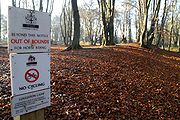
Loughton Camp
Encyclopedia

Iron Age
The Iron Age is the archaeological period generally occurring after the Bronze Age, marked by the prevalent use of iron. The early period of the age is characterized by the widespread use of iron or steel. The adoption of such material coincided with other changes in society, including differing...
(~500 BC) Hill fort
Hill fort
A hill fort is a type of earthworks used as a fortified refuge or defended settlement, located to exploit a rise in elevation for defensive advantage. They are typically European and of the Bronze and Iron Ages. Some were used in the post-Roman period...
in Epping Forest
Epping Forest
Epping Forest is an area of ancient woodland in south-east England, straddling the border between north-east Greater London and Essex. It is a former royal forest, and is managed by the City of London Corporation....
, one mile (1.6 km) North West of the town of Loughton
Loughton
Loughton is a town and civil parish in the Epping Forest district of Essex. It is located between 11 and 13 miles north east of Charing Cross in London, south of the M25 and west of the M11 motorway and has boundaries with Chingford, Waltham Abbey, Theydon Bois, Chigwell and Buckhurst Hill...
.
The camp's earthworks cover an area of approximately 10 acres (4 hectares) and are visible today as a low bank and ditch encircling the main camp. The banks were most probably once a single high rampart, used for defence and the appearance of the ditch suggests it was once very wide and deep in places.
The camp lies on one of the highest points in the surrounding area, on a ridge of high ground, likely to have once been strategic. It is speculated that the camp was used by the Trinovantes
Trinovantes
The Trinovantes or Trinobantes were one of the tribes of pre-Roman Britain. Their territory was on the north side of the Thames estuary in current Essex and Suffolk, and included lands now located in Greater London. They were bordered to the north by the Iceni, and to the west by the Catuvellauni...
in defence against the Catuvellauni
Catuvellauni
The Catuvellauni were a tribe or state of south-eastern Britain before the Roman conquest.The fortunes of the Catuvellauni and their kings before the conquest can be traced through numismatic evidence and scattered references in classical histories. They are mentioned by Dio Cassius, who implies...
. Its elevation suggests that the camp was possibly once a lookout post. However, it may have simply been used as fortification for protection of cattle. A stone Iron Age grain millstone (quern) was found close by. More colourfully, local legend has it that Boudica
Boudica
Boudica , also known as Boadicea and known in Welsh as "Buddug" was queen of the British Iceni tribe who led an uprising against the occupying forces of the Roman Empire....
used the Camp, and that Ambresbury Banks
Ambresbury Banks
Ambresbury Banks is the name given to the remains of an Iron Age hill fort in Epping Forest, Essex, England.According to legend, it is the site of the last stand by Boudica against the Romans in the year 61. There is no evidence to support this; other theories for the location of the battlefield...
was the site of her defeat in AD61 however there is no evidence to corroborate this.
The South Western edge of the camp falls away sharply to an area known as Kate's Cellar (a hermit who reputedly once lived in this area of the forest). An early 19th Century map shows Dick Turpin's hideout
Turpin's Cave
Turpin's Cave is an area of Epping Forest in Essex which has been attributed as a hiding place of the highwayman Dick Turpin.Dick Turpin knew Epping Forest well and organised many criminal activities from a base between the Loughton Road and Kings Oak Road, which in legend became known as 'Turpin's...
here (there are a number of locations which within Epping Forest's 6000 acres (24.3 km²) which claim the same).
The camp was 'discovered' by Mr Benjamin Harris Cowper in 1872. The first archaeology carried out was by General Pitt-Rivers
Augustus Pitt Rivers
Lieutenant-General Augustus Henry Lane-Fox Pitt Rivers was an English army officer, ethnologist, and archaeologist. He was noted for his innovations in archaeological methods, and in the museum display of archaeological and ethnological collections.-Life and career:Born Augustus Henry Lane-Fox at...
in 1881. In 1882 the Essex Field Club further excavated the banks.
A corresponding camp Ambresbury Banks
Ambresbury Banks
Ambresbury Banks is the name given to the remains of an Iron Age hill fort in Epping Forest, Essex, England.According to legend, it is the site of the last stand by Boudica against the Romans in the year 61. There is no evidence to support this; other theories for the location of the battlefield...
exists closer to the town of Epping. Both are Scheduled Ancient Earthworks and, as such, must only be explored on foot.

